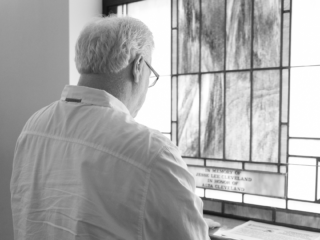When I was little boy, I went to a small mill village church in Huntsville Alabama. Our pastor, Reverend G.D. Barrett was a gifted preacher. I think it was listening to him that made me want to become a preacher. He could paint a picture with his words that forced you to do something. After all, you just couldn’t listen to a sermon like that and then walk away as if nothing had happened. I joke with my friends that if “Brother Barrett” preached on hell, your clothes smelled like smoke at the end of the sermon.
His best sermon was from Ezekiel 37, the story of dry bones. Do you remember it? God takes Ezekiel to the place of a famous battle where the bones of the fallen soldiers had been left to bleach in the sun. God asks the prophet, “Son of man, can these bones live?” I can still remember sitting on the wooden pews of Huntsville Park Baptist Church and being mesmerized by the story of the bones of dead people becoming a crowded congregation.
I hadn’t thought about that sermon until a few years ago. One day, I was reading the paper when I noticed several church buildings for sale. I’m a sucker for sacred spaces, so seeing these ads was particularly painful for me. I had noticed this trend before. Church sanctuaries and cathedrals are being converted all over the world. They are taking these sacred structures and turning them into upscale restaurants, condominiums, and office buildings. I don’t blame the people for buying these buildings. They are beautiful structures.
I just hate seeing churches sold. I especially hate seeing them sold in Middle Tennessee.
Now, understand. These churches are being sold by a group of people who are sure no one will come to a group of people who are sure someone will come if there’s something different in the building.
Why can’t a new church be what’s different in the building?
That’s why the revitalization of churches in transition is one of the major efforts of the Middle Tennessee Initiative. There are several advantages to this approach.
The church facilities are still in a good location. True, the neighborhoods around the church have changed, but there are still people around the church. Most of the time, there are a lot of people around the church. Perhaps a different ethnic group has moved in. Maybe a different language group has moved in, but there are still people who need to hear the gospel.
This new neighborhood may not match the old membership of the church. (Most of the time, it’s Caucasians driving in from the suburbs to the old home church. Not always, but most of the time.) If the church can seize the challenge of the new opportunity, the church can be restored to a vital and kingdom-impacting ministry. Yes, it probably means a new pastor and a new staff, but the church can stay alive.
Second, working with a church like this means you have a ready-made facility to use. Sure, there are usually some upgrades that have to be installed, but this can be done for nickels on the dollar. For one thing, you’d never be able to find the land, and second, who can afford a building with stained glass windows?
Third, the neighborhood is usually glad to welcome a new congregation because the church adds value to the neighborhood…or it should anyway. The facility is painted and repaired. The grounds are kept neat and trimmed. People are coming in and out. There’s life in the neighborhood.
We’ve seen it happen again and again. A church that was down to 25 or so members explodes to a weekly attendance of well over 100 and sometimes 200 or more! The looks on the original members’ faces when they hear babies crying in their worship services is priceless.
The last thing about revitalizing churches is you never run out of things to do. There’s always another church, always another people group that needs to be reached, always another challenge. We’re never bored.
But how good it is to see our God work. To stand like Ezekiel and look at the valley of dry bones and hear God say, “Son of man can these bones live?”
I love being able to answer, “Yes, Lord, these bones can live. We’ve seen You do it before.”









